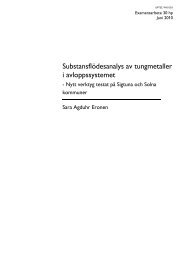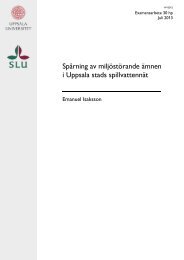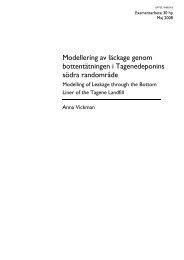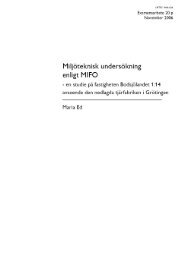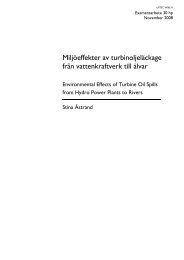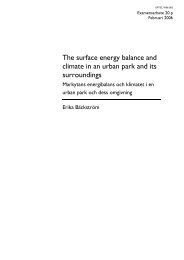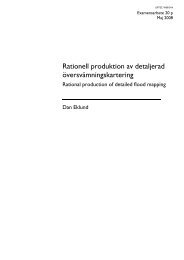Nutrient Transport Modelling in the Daugava River Basin - DiVA Portal
Nutrient Transport Modelling in the Daugava River Basin - DiVA Portal
Nutrient Transport Modelling in the Daugava River Basin - DiVA Portal
Create successful ePaper yourself
Turn your PDF publications into a flip-book with our unique Google optimized e-Paper software.
simulation system CatchmentSim. The purpose of <strong>the</strong> study is also to evaluate <strong>the</strong>model and <strong>the</strong> simulation system and po<strong>in</strong>t out strengths and weaknesses that should beconsidered when apply<strong>in</strong>g <strong>the</strong> model to <strong>the</strong> rest of <strong>the</strong> Baltic bas<strong>in</strong>.2. BACKGROUND2.1 EUTROPHICATION OF THE BALTIC SEA<strong>Nutrient</strong>s such as nitrogen and phosphorus are vital to life on land and <strong>in</strong> water.Moderate <strong>in</strong>put of nutrients to water systems may be beneficial for fish catches s<strong>in</strong>ce itwill <strong>in</strong>crease <strong>the</strong> growth of macrophytes. However, an overfertilization will lead to anexcessive growth and <strong>the</strong> bacterial decay of organic matter may lead to oxygendepletion, especially at <strong>the</strong> deep bottoms of <strong>the</strong> sea. Due to this <strong>the</strong>re will be analteration of <strong>the</strong> ecological community structure. Some species will be favoured whileo<strong>the</strong>rs will be disadvantaged <strong>in</strong> <strong>the</strong> altered environment. This is called eutrophication(Clark, 2001). Phosphorus is usually <strong>the</strong> limit<strong>in</strong>g nutrient <strong>in</strong> fresh water but also <strong>in</strong> someparts of <strong>the</strong> Baltic Sea, for <strong>in</strong>stance <strong>the</strong> Bothnian Bay. In sal<strong>in</strong>e water, nitrogen isgenerally <strong>the</strong> limit<strong>in</strong>g nutrient, which is <strong>the</strong> case <strong>in</strong> most parts of <strong>the</strong> Baltic Sea(BOING, 2002). The anthropogenic sources of nitrogen and phosphorus are leakagefrom agricultural land and forested land, po<strong>in</strong>t source discharges from waste watertreatment plants and <strong>in</strong>dustries, leakage from septic systems, deposition from <strong>the</strong>atmosphere and release of phosphorus from <strong>the</strong> sediments dur<strong>in</strong>g anoxic conditions(SMHI, 2005).Eutrophication has long been considered to be one of <strong>the</strong> most serious threats to <strong>the</strong>Baltic Sea environment. The nitrate concentration <strong>in</strong> <strong>the</strong> Baltic Sea south of <strong>the</strong> ÅlandSea <strong>in</strong>creased almost threefold from <strong>the</strong> 1960’s to <strong>the</strong> 1980’s. A pronounced <strong>in</strong>crease ofplankton production has been noticed <strong>in</strong> this part of <strong>the</strong> Baltic Sea and <strong>the</strong> area ofanoxic bottoms has likewise <strong>in</strong>creased. Nowadays, about one third of <strong>the</strong> bottom area of<strong>the</strong> Baltic Sea is anoxic (SWEPA, 2003) and anoxic bottoms are found <strong>in</strong> more shallowareas than earlier. S<strong>in</strong>ce <strong>the</strong> 1970’s, when <strong>the</strong> problem of eutrophication of <strong>the</strong> BalticSea became apparent, a lot of efforts have been made by <strong>the</strong> countries surround<strong>in</strong>g <strong>the</strong>sea <strong>in</strong> order to master <strong>the</strong> problem and reduce <strong>the</strong> nutrient loads (HELCOM, 2004). Forexample, <strong>in</strong> Sweden <strong>the</strong> regulations for storage and spread<strong>in</strong>g of manure and for <strong>the</strong>proportion of cultivated land that has to be vegetationcovered dur<strong>in</strong>g fall and spr<strong>in</strong>ghave been sharpened. Artificial wetlands have also been constructed <strong>in</strong> agriculturalareas and waste water treatment plants <strong>in</strong> sou<strong>the</strong>rn Sweden have <strong>in</strong>troduced nitrogenpurification (SWEPA, 2003). However, <strong>in</strong> spite of all <strong>the</strong> efforts <strong>the</strong> nutrient loads fromland have not decreased significantly. One reason for this is probably <strong>the</strong> long retentiontime of nutrients <strong>in</strong> agricultural soils. It is evident that it will take a long time until wewill see an improvement of <strong>the</strong> situation <strong>in</strong> <strong>the</strong> Baltic Sea, but by active and coord<strong>in</strong>atedmeasures taken by <strong>the</strong> countries <strong>in</strong> <strong>the</strong> region this time can be shortened (HELCOM,2004a).2



